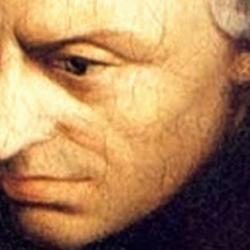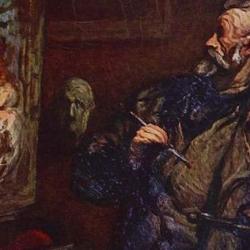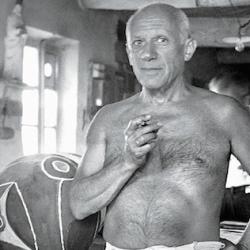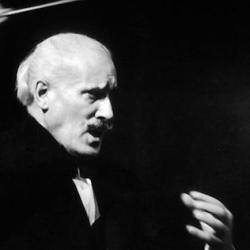Maitre Frenhofer stands with Pygmalion and Orpheus in the pantheon of influential fictional artists. The painter of the Unknown Masterpiece (or Unrecognized Masterpiece) in Balzac’s Le Chef-d’œuvre inconnu, Frenhofer’s utter devotion to his art inspired Cezanne, Picasso, and Rilke. The best-known testimony comes from Emile Bernard’s recollection of Cezanne: “One evening when I was speaking to him about The Unknown Masterpiece and of Frenhofer, the hero of Balzac’s drama, he got up from the table, planted himself before me, and, striking his chest with his index finger, designated himself—without a word, but through this repeated gesture—as the very person in the story. He was so moved that tears filled his eyes” (quoted in Dore Ashton, A Fable of Modern Art, 9).
Rilke retold the story with some variations in one of a series of letters about Cezanne:
But in the midst of eating he stood up, when this person told about Frenhofer, the painter whom Balzac, with incredible foresight of coming developments, invented in his short story of Chef-d’œuvre inconnu . . . and whom he has go down to destruction over an impossible task, through the discovery that there are actually no contours but rather many vibrating transitions—learning this, the old man stands up from the table in spite of Mme Brémond, who certainly did not favour such irregularities, and, voiceless with excitement, keeps pointing his finger distinctly towards himself and showing himself, himself, himself, painful as that may have been. It was not Zola who understood what the point was; Balzac had sensed long ahead that, in painting, something so tremendous can suddenly present itself, which no one can handle. (quoted in Ashton, 58)
Frenhofer, c’est moi.
Dore Ashton suspects that Picasso never finished Balzac’s (very short) novella, but that didn’t keep him from depicting Maitre Frenhofer in etchings and engravings. According to Ashton, “what most affected Picasso in the beginning was not so much the tragic story of Frenhofer as the role of women in the artists’ lives, just as Balzac’s first version was more directed to the love story of Gillette than to the aesthetic questions posed in the final version. Like Balzac, Picasso would only later dwell on the implications for the artist himself as epitomized in the Rembrandt-like portrait of Frenhofer. If Picasso had read the Balzac story thoroughly while at work on the thirteen etchings in the Vollard edition—no one can be sure—it is quite apparent from the etchings that what most affected him was Frenhofer’s total obsession with the painting itself which, in the old Pygmalion mythology, was to become so real as to serve as mistress and beloved” (Ashton, 90).
In his introduction to a recent edition of the novella, Arthur Danto suggests that the Frenhofer’s unrecognized masterpiece is the first Modernist painting. This in a story published in 1831!
Balzac’s story recounts a fictional encounter between the fictional Frenhofer and two real artists that took place in 1612. Franz Pourbus was the leading portrait painter of his time, the official portraitist to Marie de Medici, then Queen Mother and Regent of France. Balzac’s other real artist, Nicholas Poisson, is a young prodigy, as yet unknown. The single student of the legendary Flemish painter Jan Mabuse (also real), Frenhofer represents the best of artistic tradition (Danto matches the painters to past, present, and future). The three first meet at Pourbus’s studio, where Frenhofer critiques and corrects Pourbus’s painting of St. Mary of Egypt. While Pourbus’s painting is workmanlike, it lacks life and soul. For Frenhofer, the goal of the artist is not to imitate nature, but to express it. “A woman tilts her head this way, she holds her skirt like that, her eyes melt with a look of submissive sweetness, the shadow of her lashes tremble just so on her cheeks! That’s it—and that’s not it. What’s lacking? A trifle that’s nothing at all, yet a nothing that’s everything. You’ve got the appearance of life, but you don’t express it overflowing abundance, that je ne sais quoi which might even be the soul, floating like a cloud over the envelope of flesh” (15-16). Pourbus and Poisson watch in awe at the transformation that Frenhofer effects with a few strokes onto Pourbus canvas. They declare him to be a god of art.
Frenhofer has himself been working on his own life’s work, a portrait of a former lover, Catherine Lescault. The other painters are eager to see it, but Frenhofer refuses. The painting is unfinished, and to finish it, he needs the inspiration of an ideal living woman, a beauty unmarked by any flaw. Poisson happens to know such a woman, his mistress Gillette, and he and Pourbus eventually convince Frenhofer to show them his painting in exchange for permission to use Gillette as a model. Gillette understandably feels used, sacrificed to Poisson’s greater passion for painting, but she reluctantly agrees. As Picasso recognized, the exchange turns on the parallelism of the artistic and the erotic gaze.
When Frenhofer finally presents his masterpiece to the other painters, they are dumbfounded. They see “nothing”—only a “wall” of paint without form or definition; the only human feature is an exquisitely rendered foot in one corner. After a moment of despair at his failure, Frenhofer declares, “By the body and blood of Christ, the two of you are envious thieves who want me to believe I’ve spoiled her so you can steal her from me! But I can see her! . . . I see her, and she is marvelously beautiful!” (43). The story ends in tragedy: Gillette knows that she and Poisson are finished, and the next day Frenhofer is found dead in his shadowy studio, having burned all his paintings.
Much of the theory of painting that Frenhofer elaborates is standard-issue Romanticism, but Balzac fastens self-consciously on the critical dilemma that faced Romantic artists. Frenhofer’s Catherine is to him a living woman, “a woman with whom I weep and laugh and talk and think.” If he let her be seen in public, he would “cease being a father, a lover, and God Himself.” Foreshadowing his eventual end, Frenhofer says, “I’m strong enough to burn my Catherine as I draw my dying breath, but to compel her to endure the gaze of a man, a young man, a painter? No, no! If anyone sullied her with a glance, I’d kill him the next day. . . . you’d have me subject my idol to the cold gaze and stupid criticisms of fools?” (34). The closer she gets to perfection, to life, the more reluctant he is to show her to the world: “Poetry and women show themselves naked only to their lovers!” (34). The perfect painter is the perfect lover, and thus paints only for himself. Were he to share Catherine, his love would be as doomed as that between Gillette and Poisson. Because his painting so perfectly expresses its subject, because it is so nearly alive, he cannot show her off without prostituting her.
Frenhofer to the contrary, the dilemma isn’t inherent in art. It’s a self-imposed dilemma, the result of an artistic stance that already verges toward solipsism. M.H. Abrams characerized Romantic aesthetics as an aesthetics of self-expression. For Romantics, art doesn’t aim at mimesis, but at authenticity: The greatest art is that which best expresses the powerful overflow of the artist’s feelings and emotions. The poet or artist isn’t a mirror but a lamp, illuminated by an inner fire and casting light into the world. Eric Gans puts the dilemma in terms of the roles of creator and spectator: “Frenhofer . . . wishes to combine the absolute domination of the creator-subject with the desire of the ‘other’: by placing himself on both sides of the formal barrier at once, he can behave as though no such barrier existed.” This fusion is possible in a “purely solipsistic universe”; in Balzac’s final version of the story, he emphasizes “the artistic failure that must result from this lack of respect for esthetic form: the attempted fusion of desire and fulfillment destroys the objective reality of the appearance that is to arouse the desire of the spectator.” Gans thus sees the story as a vindication of Balzackian realism, “a demonstration of the ultimate capacity of the classical esthetic to ‘deconstruct’ any attempt at romantic transcendence founded on the imaginary.” The story simultaneously points to “the modern conception of an art whose content is no longer the image of the ideal, but the sensuous record of its pursuit” (Gans, “Balzac’s Unkowable Masterpiece and the Limits of the Classical Esthetic,” The French Issue 90:4 [May, 1975] 504-516).
If art is conceived not as self-expression but as service, Frenhofer’s dilemma evaporates. The artist need not play the incompatible roles of God, father, lover, and so he no longer incestuously demands exclusive rights to his work. It is his in that he creates it; but it is not his in that he creates it for the sake of patron or public. The artist does not turn into a pimp when he releases his beloved to the world. Art, and the talent or genius that enables it, is one of the goods that, according to Augustine, is possessed only by dispossession, possessed only when it is given away (On Christian Teaching).















